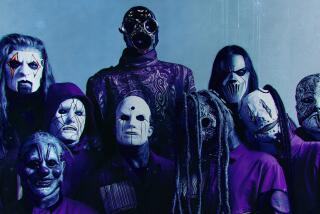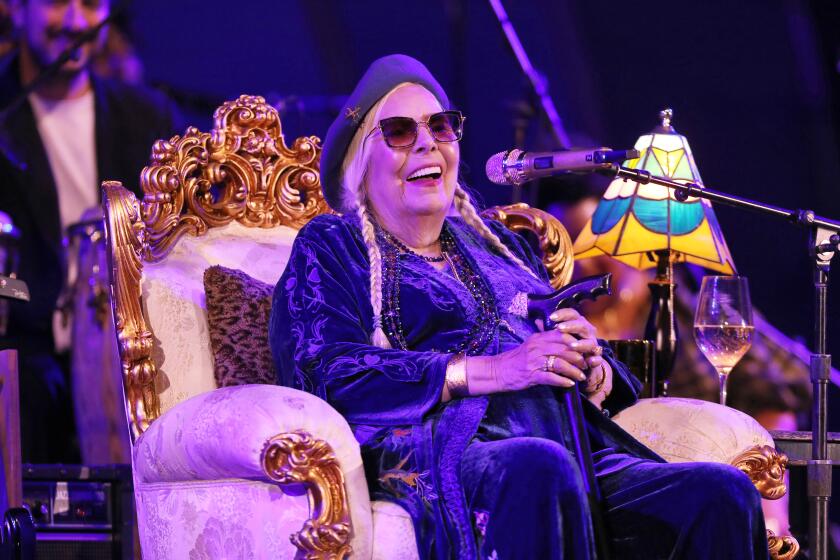Landmark Album Comes Full Circle
Imagine, if you will, an album conceived by a Los Angeles-based producer pairing contemporary musicians with a slew of bluegrass and country music legends singing songs mostly from the early 20th century--and it turns into a surprise hit on the pop charts?
Oh, brother....
Actually, almost three decades before producer T Bone Burnett put the “O Brother, Where Art Thou?” soundtrack together, another album did much the same thing: the Nitty Gritty Dirt Band’s “Will the Circle Be Unbroken,” which is being reissued this week to mark the album’s 30th anniversary.
“I thought it was real nice of them to plan all that success to coincide with us putting ‘Circle’ out again,” jokes John McEuen, the Dirt Band’s banjo player and fiddler, who reunited with the group last year after a decade pursuing solo projects.
“The main parallel I would draw,” he adds, “is that both albums showed there’s a huge audience for this kind of music, if people know where to find it.”
Just as “O Brother” has led a new audience to the wellspring of American mountain music, folk and blues, and to performers who rarely show up on the pop charts, the “Circle” album pointed countless rock and pop fans toward vintage country, bluegrass and folk music when it came out in 1972.
The Southern California-bred country-rock group teamed on the three-LP set with the likes of banjo virtuoso Earl Scruggs, country music matriarch Mother Maybelle Carter, Grand Ole Opry patriarch Roy Acuff, guitar whizzes Doc Watson and Merle Travis and others on such songs as the Carter Family’s “Wildwood Flower,” Acuff’s “The Precious Jewel” and Dorothy Dixon’s “Wreck on the Highway.”
The performers also can be heard chatting between songs, figuring out arrangements, making instrumental choices or just getting to know one another, as in a conversation between Watson and Travis, who had long admired each other’s work but had never met until they were invited to play with the Nitty Gritty Dirt Band.
It was a risky move at a time when there was little intersection between pop and country circles. Additionally, the country music establishment had largely turned its back on the veterans the Dirt Band most admired: One Nashville publication at the time labeled the “Circle” participants “dinosaurs” because their music seemed light-years removed from the smooth pop-sounding “countrypolitan” records coming out of Music City at the time.
But it built a bridge between the pop and traditional country worlds that continues to be walked today. “To my mind, the ‘Circle’ album opened the doors to the collaborations we’ve seen, like Travis Tritt recording with the Eagles, or Rob Thomas co-writing songs for Willie Nelson’s latest album,” says Deborah Evans Price, associate editor of country and Christian music for Billboard. “That happens frequently now and nobody bats an eye, but there wasn’t hardly any of that going on back then. The Nitty Gritty Dirt Band kind of blazed that path.”
Similarly, country radio today has ignored the kind of raw, rural music championed on “O Brother” in favor of slicker pop-country fare that had dominated country radio for at least a decade.
Since “O Brother” won the Grammy for album of the year in February, however, country stations have begun playing music from it with greater success.
“It was very timely, because the Grammys were on a Wednesday night, and the country radio industry was in Nashville convening that week for the annual Country Radio Seminar,” says R.J. Curtis, program director for Los Angeles country station KZLA-FM (93.9). “O Brother’s” Grammy win “was the hot topic there, and the following Monday, ‘A Man of Constant Sorrow’ was one of the most added recordings across the nation, KZLA included.”
Curtis says that when the station played the same song last year, listeners recognized it but didn’t like it.
In playing the same song since the Grammys, Curtis says KZLA listeners give it an even higher familiarity rating in the station’s call-out research, but now the approval rating has shot up as well.
“When the direction to [roots music] is an easy path, people will like it,” says McEuen, “and what’s great about that movie is it helped open more eyes to see where to find it.”
Still, most country observers agree that it will be months, years even, before the verdict is in on whether the “O Brother” phenomenon represents an intriguing aberration or a genuine revolution. In 1972, the Dirt Band also was flying blind.
“We kind of risked our whole career to record with the people who were our influences,” McEuen says. “If that album had stiffed, or we got into the studio and nothing worked, it would have been really embarrassing. But it happened so quick that the power of the music took over.”
Indeed, instead of selling a few thousand copies to hard-core country and bluegrass fans, “Will the Circle Be Unbroken” went on to sell more than 1 million copies, helping open the eyes and ears of pop fans to sounds that contributed to the birth of rock ‘n’ roll while opening doors in country music to new musical possibilities.
The “Circle” reissue is a two-CD package that revives the original artwork, features sound remastered from the original tapes and adds a couple of rediscovered songs and more dialogue from the marathon sessions recorded over six days in August 1971.
“We were just a bunch of kids, all in our early 20s,” recalls Dirt Band singer-songwriter-guitarist Jeff Hanna. “The whole experience of recording it was so quick--it took less than a week to make--that it seemed at the time like kind of an exciting blur. But as time has gone on, the scope of the project has taken on a much bigger meaning. It’s become more important to a lot of people, because it spanned generations and cultures.”
As was the case with “O Brother,” success for “Circle” seemed remote at best when it was being recorded. The Nitty Gritty Dirt Band was at its commercial peak, yet the biggest hit of its career, a 1970 version of Jerry Jeff Walker’s “Mr. Bojangles” that reached No. 9 in Billboard, hardly put the band in Midas-touch territory.
The genesis of the “Circle” album was an encounter with Scruggs, who brought his family to hear the Dirt Band perform in Nashville one night because Scruggs’ children were fans.
Band members nervously asked him after the show if he’d ever consider recording a song with them and were pleasantly surprised when he consented. That led them a little while later to extend a similar invitation to Doc Watson, using Scruggs’ promise as their calling card.
“At that point, Bill [McEuen, John’s older brother who was the Dirt Band’s producer] pulled us aside and said, ‘I have this concept: Let’s do a record where you guys play with all of your heroes, all these icons.’”
The band’s longtime members--Hanna, McEuen, Jimmy Ibbotson, Jimmie Fadden--had developed an affinity for roots music despite growing up in Long Beach and Orange County in the 1960s, when most of their peers were more interested in hearing the latest hits by the Beatles, the Rolling Stones and the Beach Boys than decades-old music of the Carter Family and Bill Monroe.
Like many pop and rock aficionados, they pored over the credits of then-popular folk albums by Bob Dylan, the Kingston Trio, Peter, Paul & Mary and others to find out where the songs they were singing originated. That led them, Hanna says, to the source: folk, blues and country artists including Flatt & Scruggs, the Carter Family, Mississippi John Hurt, Sonny Terry & Brownie McGhee and Doc Watson.
Yet even though musicians ranging from Dylan and the Byrds to Linda Ronstadt and Rick Nelson had been experimenting with melding country and rock since the mid-’60s, Nashville still cast a wary glance on rock in the early ‘70s, which made the Dirt Band’s proposal all the more daring.
“That cliche about the hippies and the rednecks getting together, that had some weight,” Hanna says. “The music was the real common ground, and I think that’s what broke down any apprehension there had been.”
Over time, Hanna adds, he values the feeling of community that developed more than any particular performance or anecdote that came out of the original “Circle” recording sessions.
“All those memories have become more special to us because we’ve lost so many of these folks since then,” he says. “I keep saying this, but it’s true: I felt as if we were being welcomed into a family. It started with Earl Scruggs and his family, but it extended to that entire family of musicians we met on those sessions.”
The Dirt Band members see the success of “O Brother” as proof anew of the timeless power of the seminal music they set out to celebrate 30 years ago.
“With some music you hear on the radio, sometimes you can’t envision real people playing it,” says McEuen. “There’s something about acoustic music--not just bluegrass--but all acoustic music that makes you feel that it’s made by real people. One thing I think the ‘Circle’ album does, it makes you feel that you’re getting to know the people who are playing, and that they are telling you a story with music, and that it’s a story that they believe in.”
More to Read
The biggest entertainment stories
Get our big stories about Hollywood, film, television, music, arts, culture and more right in your inbox as soon as they publish.
You may occasionally receive promotional content from the Los Angeles Times.










